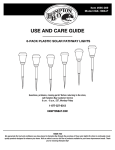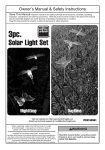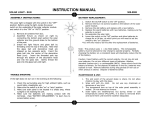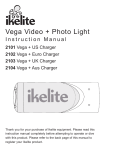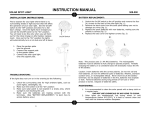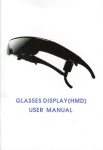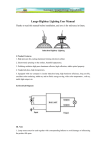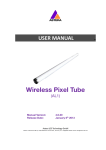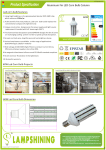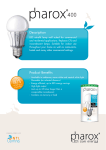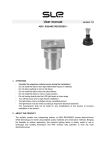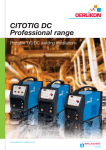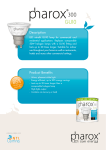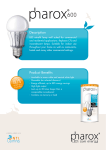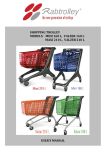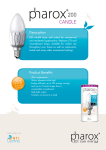Download View - Orient Electric
Transcript
LED Focus Illuminating the growth path for industries The search for a sustainable lighting system for industries ends with the latest LED lighting options available in the market. These lighting systems ensure continuous productivity, come with automation capabilities and also help reduce a company’s carbon footprint. Read on to figure out which technology suits your requirements By Gunjan Piplani P Industrial lighting, which according to Naveen Saxena, country head - India, Opple Lighting, constitutes nearly 20 per cent of the total LED lighting business, is an emerging area for LED lighting. In fact, market reports that project the Indian LED lighting market to reach US$ 2.2 billion by 2021, observe that the industrial sector will be one of the key growth areas. To reduce power consumption by half, adopt LEDs “Moving from halogen, sodium vapour, mercury and metal halide lamps to LED lighting systems is the latest trend in the industrial lighting segment,” shares Puneet Dhawan, business head-lighting division, in ight for stallation e h :3 of m e ng m 40 Ra lanning to set up a new manufacturing unit or revamping your current one into a more environment-friendly space? Selecting the right lighting is a critical element in the process. Lighting constitutes nearly 10 per cent of the total cost of setting up or even running a plant, and hence can deliver substantial savings if you invest in the right product. LED industrial lighting is proving to be the right choice for industries looking at a new or revamped unit. It is gaining prominence as the need for environment friendly, low energy- consuming and maintenance-free systems grows. Moreover, lighting plays a vital role in industries as it is directly linked to productivity and creating a better work environment. Today, even the government is offering incentives to units installing energy-saving systems, which includes lighting. According to the National Manufacturing Policy issued by the Department of Industrial Policy and Promotion under the Ministry of Commerce and Industry, using energy-saving lighting systems, makes a manufacturing unit eligible for up to a 5 per cent interest reimbursement of the nominal interest charged by a lending agency or a 10 per cent capital subsidy. 20 • Electronics Bazaar • July 2015 • Supplement • www.electronicsb2b.com LED Focus Opple’s Highbay Performer •• Colour temperature: 5700K •• Variants available are 50W, 150W and 200W •• CRI >80 Latest Pharox Warhorse - NTL Lemnis •• •• •• •• Housing: Pressure die cast aluminium IP 65 ingress protection Impact resistant polycarbonate optical dome cover Available in 40W in the market Orient Electric’s Pinnacle •• •• •• •• Input power: 110W Housing: Pressure die cast aluminium CRI >70 Lumen output: 8000 Orient Electric. Industries that used 250W conventional lamps are now replacing them with 100-110W LED luminaires, thus bringing down their energy consumption to half the earlier levels. The commonly-used LED luminaires in industry include high bay, medium bay, low bay, well glass, tubelights, flame-proof and dustproof lamps, and floodlights. These LED industrial products are available both in high power LEDs as well as in chip-on-boards (COBs). Rajesh Naik, general manager luminaires, Crompton Greaves Ltd adds, “Technologically, LEDs are achieving high efficacy, giving more light in lower watts, and enabling more energy savings over conventional lights. Added to this is the COB technology, which helps to de- l Colour temperature: 5500K Installation do’s and don’ts •• The installer should be thorough with the user manual •• The product should be installed by a qualified professional electrician •• There should be a separate lighting transformer •• Proper earthing must be provided for the luminaire •• There should be appropriate load distribution liver high power and better efficacy. Today, products are meeting a total harmonic distortion (THD) of less than 10 per cent and a power factor (PF) of more than 0.9.” LEDs have gained momentum in the industrial lighting segment as they are low on maintenance, linear in design, have a long life and, most importantly, offer even light distribution. Talking about bringing a wider usability, Arun Gupta, MD, NTL Group, shares, “LED lighting systems are technologically more advanced in many ways, compared to conventional industrial lighting products. It is now possible to get any colour of light, be it white or yellow, from LED industrial lighting solutions, as opposed to sodium vapour lamps that only offer yellow light. Nowadays, high power LEDs are available, which have better efficacy than their predecessors, with more efficient cooling systems. Also, fewer LEDs mean better optical control.” Making an ‘intelligent’ move: The arrival of intelligent lighting systems has accelerated the adoption 21 • Electronics Bazaar • July 2015 • Supplement • www.electronicsb2b.com LED Focus Types of industrial lights High bay lights: Used in plants, sheds and mounted at high ceiling heights of over 7m. Floodlights: Used to illuminate a large area. Well glass: Used to illuminate a task area, generally mounted at lower heights of less than 5m. Tubelight fixtures: Used in lower heights of less than 3m, and also outdoor applications in weather-proof variants. Flameproof fixtures: Used in hazardous areas where flammable gases might be present. These fixtures need mandatory certifications from government laboratories. Streetlights: Used to illuminate roads and walkways inside the plant premises. High masts with floodlights: Used to illuminate large open areas with very high mounting heights up to 30m. —Inputs from Rajesh Naik, general manager - luminaires, Crompton Greaves Ltd of LED lighting systems in industries. These systems offer additional capabilities like sensor based lighting, which turns off automatically after a certain period of inactivity; remotely operated systems that can be controlled through Wi-Fi or the global system for mobile communications (GSM) connection, which helps in switching lights on or off; and time based lighting systems, where a particular light can be timed to switch on and off. With the incorporation of these intelligent systems, the advantage of LEDs saving energy becomes more prominent. The installation of these intelligent systems, according to Saxena, is currently being outsourced to channel partners, who are also trained to maintain these systems. Clients are designated to channel partners based on their location. Customised for the unique needs of your industry: Different industries have their own requirements. For instance, the food industry with its high safety requirements will need lighting systems that are dust-free, low on maintenance, and have no heat impact on the food. Dhawan shares, “The food industry can have a customised solution, wherein the luminaire can be opened from the top and not the bottom. So when maintenance is required, it can be done within the luminaire without causing any spilling of dust or even any waste.” Says Saxena, “For industries dealing in chemicals, there is the need for specially designed luminaires that generate minimal heat, so that they do not have an effect on the product that is being manufactured.” Talking of the textile industry, Naik says, “This industry needs inplant lighting with higher lux levels (up to 500 lux) and a better colour rendering index to know the true colour of the yarn or cloth. Moreover, the mounting heights are lower than 3m. And since most of the manufacturing process is manual, the lighting should not result in glare. So we have developed a box type tubelight fixture, which provides high lumen output at 100 lumens/ watt, with high CRI.” Similarly, in the steel industry, the plant’s ceiling could be as high as 15m to 40m. Luminaires mounted at such heights are expected to give the desired light at the working plane. Moreover, higher ambient temperatures, dust and ash in the air, safe mounting to withstand jerks, etc, are important considerations when illuminating steel plants. Generally, orders for customised products and even for intelligent systems are being taken up by brands only when high volumes are needed. Choose your brand and luminaire with care Industrial lighting is an institutional purchase decision, wherein a buying decision is based on the customisation possible. Customers need to put across their requirements including height, light required, number of luminaires and also automation systems. Adding to these basic needs, buyers also need to know the brand or company that they are going to work with – particularly its reputation for delivering on service support commitments for longer warranties. Naik adds, “Buyers need to be careful while selecting their lighting partner and see that the company has and can provide all the relevant data regarding certification, etc. This should cover technology – COB is the latest technology and the most useful for industrial applications; the LM 79 report – covering lumen output, CCT, PF THD as per UL guidelines; the LM80 report – LED datasheet having lumen maintenance of light source at different temperatures; a THD less than 10 per cent and PF above 0.9, which is mandatory for luminaires; ingress protection of IP65 and surge protection of at least 5kV and above.” Talking about the kind of luminaire to be chosen, Gupta of NTL shares, “Continuous and uninterrupted operations are the priority for any industrial unit. Hence, the luminaire should be maintenancefree or maintenance-friendly. It should be rugged for industrial use as it will be subjected to high temperatures, air pollution and vibrations. The lighting system should 22 • Electronics Bazaar • July 2015 • Supplement • www.electronicsb2b.com LED Focus be energy efficient and have an attractive ROI. These light fittings should be supported with LM79 reports for the credibility of various optical parameters.” Saxena of Opple Lighting points out, “The key areas that one needs to keep in mind while making a purchase decision include the industry the lighting is needed for, minimum maintenance, required certifications, and the professional support offered during and after sales.” Certifications to withstand a tough environment: LED lighting for industrial use is critical to ensure productivity and product quality, particularly because of its ability to withstand changing temperatures within the plant. So if you are installing LED lights, ensure that you look for certain important international certifications including IP 65 that testifies that the product is dust- INDUSTRIES THAT NEED LED LIGHTING 1. Automobiles 2. Pharmaceuticals 3. Petrochemicals 4. Cement 5. FMCG 6. Chemicals 7. Textiles 8. Agro 9. Power 10.Steel and aluminium proof, Conformité Européene (CE) marking, International Electrotechnical Commission (IEC) standards and RoHS compliance. Additionally, compliance with the Bureau of Indian Standards (BIS), which has also formulated LED lighting certification, is important. Going beyond mere sales: After- sales service is the next important step in LED lighting. Brands appoint an after-sales team at their headquarters and also impart training to their channel partners, so that the client is serviced in time. While the headquarters generally take the complaints and ensure they are addressed within 48-72 hours, the channel partners are delegated to resolve the issue at the client’s plant. The channel partners are well equipped with the components and tools needed to address product complaints. LED lighting is gradually turning into a necessity for industries in India. With greater industrialisation taking place in the country, this segment is poised to grow from an emerging player to a key contributor to the entire lighting industry. 23 • Electronics Bazaar • July 2015 • Supplement • www.electronicsb2b.com




